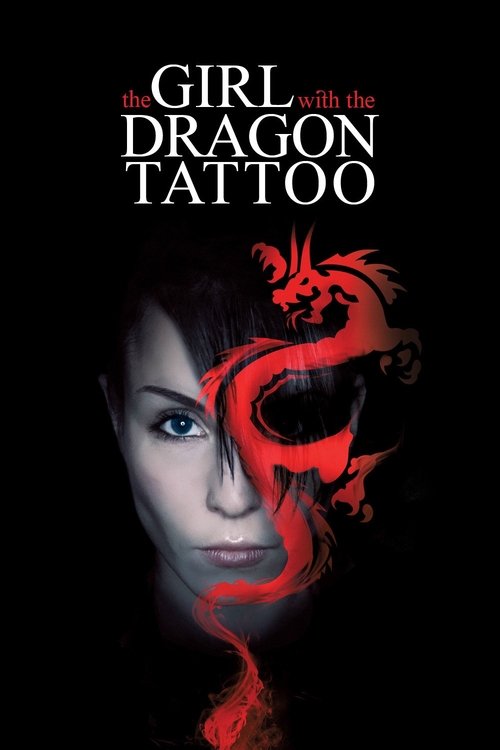
The Girl with the Dragon Tattoo
Swedish thriller based on Stieg Larsson's novel about a male journalist and a young female hacker. In the opening of the movie, Mikael Blomkvist, a middle-aged publisher for the magazine Millennium, loses a libel case brought by corrupt Swedish industrialist Hans-Erik Wennerström. Nevertheless, he is hired by Henrik Vanger in order to solve a cold case, the disappearance of Vanger's niece
Dialogues from Movie The Girl with the Dragon Tattoo
Quotes from Movie The Girl with the Dragon Tattoo
Sound Tracks from The Girl with the Dragon Tattoo by Trent Reznor, Atticus Ross
Immigrant Song
Immigrant Song by Karen O & Trent Reznor, Opening credits
The Way It Is
The Way It Is by Bruce Hornsby and the Range, Used in a pivotal emotional moment
People Help the People
People Help the People by Cherry Ghost, Played during the end credits
Download App
Memorable Scenes from Movie The Girl with the Dragon Tattoo
Lisbeth's Introduction
Lisbeth Salander's introduction is striking. We see her as a fierce and defiant character, working as a hacker for a security firm. She has a traumatic past, which we learn about slowly. Her first encounter with Mikael Blomkvist sets the stage for their complex relationship. The tension between them is palpable, as he sees her as both an ally and a challenge, and she views him with distrust but curiosity.
Context: This moment sets the foundation for Lisbeth's character. Her tough exterior hides vulnerability, allowing the audience to begin to understand her journey.
The Photograph Revelation
Mikael and Lisbeth are deep into their investigation when Lisbeth finds a disturbing photograph that hints at a dark family history. The visual of the photograph contrasts hauntingly with the film’s earlier moments, revealing hidden horrors and raising the stakes for both characters. This is a pivotal moment for Lisbeth, reinforcing her purpose while escalating Mikael's urgency.
Context: The photograph acts as a crucial turning point, connecting the mystery to Lisbeth's personal conflict and deepening the investigation.
The Interrogation Scene
This tense scene showcases Lisbeth confronting a possible suspect about a missing girl. The tension escalates as Lisbeth's emotions bubble to the surface when she feels threatened. Her vulnerability and strength clash, leading to a shocking moment that defines her character. The visuals are stark, emphasizing her determination against the odds.
Context: This heightens Lisbeth's fierce nature while showing her ability to stand up against men who abuse power.
Mikael's Discovery
While digging through the archives, Mikael uncovers shocking documents that tie the Vanger family to a series of crimes. His expressions shift from curiosity to disbelief, culminating in a moment of realization. This discovery propels the narrative into its most intense phase. The framing of the document in the dim light enhances the gravity of what he’s found.
Context: This moment is crucial as it connects the past with present horrors, pushing the plot to a new level.
The Assault on Lisbeth
One of the film's most harrowing moments occurs when Lisbeth is assaulted. The build-up is tense, as she fights back with every ounce of strength. The brutal nature of the scene is contrasted against her eventual victory, showcasing her resilience. The camera captures her transformation, cementing her transformation from victim to warrior.
Context: This moment underscores the themes of trauma and survival, leaving a mark on Lisbeth’s character development.
Lisbeth's Revenge
Following her assault, Lisbeth orchestrates a meticulous revenge against her attacker. The calm before the storm amplifies the impact as she takes control of her narrative. The visuals of her hacking and setting traps create an empowering twist, allowing the audience to cheer for her strength and determination.
Context: This moment signifies Lisbeth reclaiming her agency, showing her resourcefulness and unwavering courage.
The Family Confrontation
Mikael confronts the Vanger family members about their secrecy and the dark legacy that surrounds them. The tension is thick as accusations fly, and buried truths come to light. The the way the family dynamics play out visually adds layers to character motivations and deepens the stakes.
Context: This confrontation reveals the family's dark history, accentuating the film’s themes of complicity and secrecy.
Lisbeth's Transformation
After a series of intense events, Lisbeth undergoes a powerful transformation. The audience sees her shedding parts of her past as she embraces her identity. The cinematography captures her evolution beautifully, from a reserved hacker to an empowered fighter, intertwining her personal journey with the film's central conflict.
Context: This transformation is significant as it showcases her resilience, tying into the film's broader theme of empowerment.
The Final Showdown
The climax unfolds in a tense showdown where Lisbeth and Mikael confront the ultimate villain. The stakes couldn't be higher, with emotions running wild. The action sequences are intense, and the visuals heighten the stakes, culminating in a cathartic moment where justice is served. The resolution of this conflict is both thrilling and satisfying.
Context: This showdown acts as a culmination of the film's themes of vengeance, justice, and reclaiming one's power.
The Closing Scene
As the investigation wraps up, Lisbeth stands at the edge of a new beginning. Her interactions with Mikael reflect a deep yet complex connection. The final shot of her walking away evokes a sense of hope and uncertainty. It leaves viewers contemplating her future after confronting her demons.
Context: This closing scene is vital in establishing the enduring impact of Lisbeth's journey, symbolizing resilience and the quest for identity.
The Symbolism of the Tattoo
Throughout the film, Lisbeth's tattoo holds significance. It represents her past, pain, and strength. Moments where she interacts with it or reveals it are emotionally charged. It serves as a visual metaphor for her inner struggles and victories, resonating deeply with viewers who appreciate its symbolism.
Context: The tattoo connects deeply with themes of identity, trauma, and empowerment, marking a turning point in Lisbeth’s journey.
The Family Album
Mikael comes across a family album showcasing seemingly innocent moments juxtaposed with dark secrets. As he flips through the images, the haunting revelation of the Vanger family history begins to unfold. The irony of the cheerful photographs against the backdrop of horror strikes a chord.
Context: This moment heightens the mystery and reveals how appearances can hide deep-rooted trauma.
Lisbeth's Past
In a haunting flashback, Lisbeth recalls moments of her childhood trauma. The visual storytelling employs stark contrasts between her past and present, illustrating her struggles. The emotional weight of her history is palpable, evoking a deep sense of empathy from the audience.
Context: This scene is pivotal in understanding Lisbeth's character and motivations, enriching the film's emotional depth.
The Phone Call
During a crucial moment, Lisbeth receives a phone call that shatters her sense of safety. The tension in her expression and the framing of the scene heighten feelings of dread. This call marks a turning point for her character, forcing her to take action.
Context: This moment amplifies the sense of urgency and danger surrounding Lisbeth, escalating the plot.
The Hidden Room
Lisbeth and Mikael finally find the hidden room that reveals the dark secrets of the Vanger family. The camera work shines a light on the stark contrasts of the room, filled with relics of both beauty and horror. This discovery breathes life into their investigation, linking their findings directly to Lisbeth's journey.
Context: This moment acts as a culmination of their investigation, revealing the connections between the past and present, making the plot more gripping.
The Flash of Hope
In a moment of clarity, Lisbeth stands outside looking towards a new horizon. The visual composition reflects her potential to break free from her past. It’s a moment filled with hope, symbolizing her journey towards healing and empowerment.
Context: This scene resonates with themes of rebirth and the possibility of a future beyond pain.
The Defiant Stand
In a powerful scene, Lisbeth takes a stand against her former abuser, filled with rage and determination. The buildup leads to an explosive confrontation that showcases her strength and resilience. The visuals are impactful, representing her reclaiming her power.
Context: This moment is crucial in establishing Lisbeth's journey from victimhood to empowerment.
The Train Station Escape
The suspense peaks as Lisbeth escapes from a dangerous situation at the train station. The fast cuts and intense music amplify the adrenaline-fueled moment. This chase scene not only showcases her resourcefulness but also adds to the tension of the narrative.
Context: This escape serves as a pivotal moment in Lisbeth's struggle for safety and autonomy, emphasizing her strength.
The Final Interview
In a tense final interview, Mikael confronts Lisbeth about her past. Their conversation is charged with emotion as both characters lay themselves bare. The dialogue is raw and real, showcasing the depth of their connection and understanding, allowing the audience to see their growth.
Context: This scene highlights the relationship between Mikael and Lisbeth, providing insights into their struggles and bond.
The Revelation of the Murder
The plot thickens as Mikael uncovers the truth about the murdered girl. The emotional weight hangs heavily in the air as he puts the pieces together. The visuals and pacing create a gripping atmosphere, making the truth all the more haunting.
Context: This revelation is a significant turning point, tying together the film’s central mystery with gasp-worthy revelations.
The Quiet Introspection
There’s a quiet moment where Lisbeth reflects on her journey alone in a café. The calm ambiance gives way to her turbulent thoughts, revealing her vulnerability. The contrast between her strong façade and vulnerable thoughts is poignant, creating a relatable moment for viewers.
Context: This introspection gives viewers deeper insights into Lisbeth's psyche, humanizing her after the intense drama.
Mikael's Redemption
Mikael faces a moment of self-realization after experiencing the dangers that come with uncovering the truth. His decisions weigh upon him, leading to a change in his character. The visuals emphasize his struggle, representing a shift towards deeper understanding and accountability.
Context: This moment of redemption plays a crucial role in Mikael's character arc, paralleling Lisbeth's story.
The Haunting Past
A discovery leads to an emotional confrontation about Lisbeth’s childhood memories. The dialogue is charged as she reveals the depths of her pain, and the visuals evoke a haunting atmosphere. This moment captures the essence of her struggle and authenticity.
Context: This emotional moment deepens the narrative, shedding light on the lasting impacts of her past.
Download App








